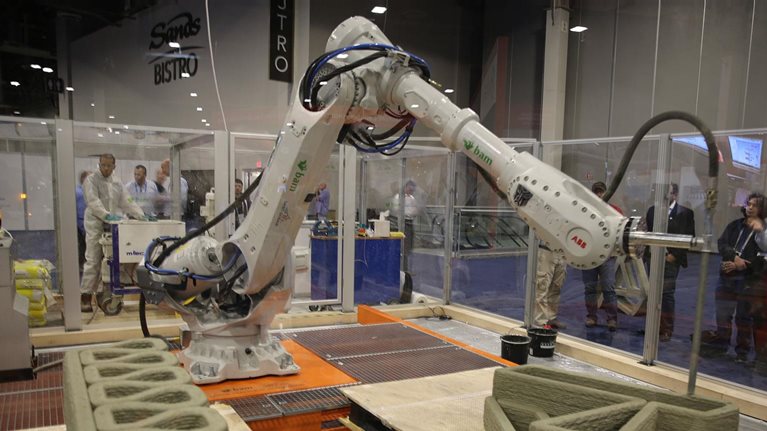Our built environment is contending with a wave of disruptive forces. Climate change is causing infrastructure owners to rethink where and how they build and power assets. Migration and urbanization are generating tectonic shifts in our transportation and infrastructure needs. And technology is altering the way we both live and work—especially as automation gains speed. On October 2 and 3, 2019, the Global Infrastructure Initiative convened more than 80 sector leaders at Building Change, a roundtable in San Francisco, to chart a path through these choppy waters.
Stay current on your favorite topics
Many conferences center on a single industry. However, we decided to orient Building Change on the increasingly interconnected and interdependent energy, infrastructure, and transportation industries. In periods of technological disruption, cross-industry conversations are crucial; in fact, organizations and leaders that succeed in breaking down functional and industry silos are most likely to thrive under these conditions.1
Our roundtable focused on three crosscutting disruptions: environmental, technological, and workforce. Bringing a diverse group of recognized experts together to bounce ideas off one another revealed that—while the challenges these industries are facing are great—leaders are devoting no shortage of innovation, creativity, and effort to attempting to solve them. Although it would be impossible to recap every conversation, this overview highlights some of the most prominent points of discussion from the conference.
Environmental disruptions
Within just the past ten years, climate events have been estimated to cost the world nearly $2 trillion in damage and directly affect nearly four billion people.2 Conducting business as usual could risk triggering irreversible climate feedbacks. Roundtable participants were loud and clear: we must act now and decisively to address climate change and limit its impact to the extent that we still can. There is, however, room for optimism.
The climate crisis has made its way to the center of almost every corporation’s agenda, as investors, employees, customers, governments, and students increasingly demand action. The companies represented at Building Change are stepping up to the challenge. Human nature seeks to innovate and solve problems, and infrastructure players aim to be part of the solution in limiting global warming.
Executives discussed how to manage decarbonization and physical climate risk to their assets, both of which require fundamental change to business models as well as entire industries.3 To cope, relationships and interdependencies across sectors should be rewritten—and therein lie opportunities for new partnerships and business models. Energy and mobility were at the forefront of the discussion.
Managing the energy transition
The need to increase investments to future-proof existing infrastructure assets and to ensure new infrastructure is built with sustainability and resilience in mind echoed throughout the roundtable. Participants affiliated with the power sector noted dual priorities: reducing emissions from existing assets while preparing the grid for inevitable climate impacts, such as from flooding or fires. All agreed that reducing energy demand would help achieve these goals.
Would you like to learn more about our Capital Projects & Infrastructure Practice?
Achieving zero-emission power
Although the road to zero-emission power is well lit, it is still very long. For example, as of 2018, renewables contributed less than one-quarter of generation capacity in the United States.4 While declining costs and regulation continue to be major drivers of renewable adoption, one participant raised the point that at-scale renewables would require rethinking how power markets are structured and how to accommodate for capacity and flexibility.
More broadly, the participants discussed technology’s role in advancing toward a zero-emission future. Companies innovating in offshore wind, hydrogen, and long-term storage are attracting increasing investments. Direct aircapture technologies (which remove emitted carbon directly from the atmosphere), though still nascent, were met with excitement. Participants noted that decarbonization innovations are not emerging solely from fringe start-ups. Traditional industry incumbents that face significant disruptions to their own business are also starting to invest more, both in their own R&D and in smaller innovators’ efforts by initiating dialogue, collaborating, and helping them scale.
Moving to zero-emission mobility
Given transportation’s contribution to greenhouse-gas emissions, electrification of mobility and ridesharing featured prominently in the discussion. While investment in charging infrastructure for personal vehicles is important, participants highlighted that achieving zero-emission mobility might require not only adopting electric and fuel-cell vehicles but also reconsidering how we integrate micromobility into the fabric of our cities at a scale and pace greater than what we see today.
Addressing equity head-on
As companies chart their paths through the environmental disruption, one consideration remains at the top of roundtable participants’ minds: equity. The most vulnerable in society are often facing the greatest consequences of climate change and potentially face the greatest challenges in adapting. Participants shared many ideas about how to ensure an equitable transition. For example, donated or subsidized solar panels and batteries in low-income neighborhoods could provide electricity at no cost to residents while also storing and distributing power, thereby enhancing the local grid’s resilience.
Technological disruptions
Data and analytics continue to represent some of the greatest opportunities to optimize asset operations and break down decision-making silos. In infrastructure, as in other industries, the use of advanced analytics can reduce the need for new capital while raising returns on existing investments. For example, the rail industry uses analytics to increase its resilience by making predictive-maintenance decisions that help avert breakdowns and major accidents. Other assets, such as roads and solar power, can learn from this experience and apply similar models.
Disruptive technologies are also enablers. Not only do they facilitate collaboration and break down internal barriers but they also allow for real-time decision making and free up more resources for creative tasks.

Voices on Infrastructure: Workforce of the future
Linking agility and empowerment
To reap the biggest benefits of technology and analytics, companies should internalize that risk stems from ignoring change, not from change itself. It may sound cliché, but many teams operate under a false sense of agility.5 Truly agile collaboration— that is, committed partnership and reciprocity rather than a flat structure of authority—is particularly critical during times of disruption.6 Those that take leaps of faith, act and fail fast, and pursue agile business models are better equipped to overcome disruption, even when the rug is pulled out from under them.
One executive noted the importance of “empowered doers,” people in the field who provide bottom-up feedback and have the authority to make decisions. In practice, that means facilitating agile collaboration between the business leaders and the engineers and operators. Indeed, technical employees cannot make decisions or build quality models without first understanding industry operations; likewise, business leaders will need enough digital literacy to ensure that the strategies they create are robust and well-resourced from a technical perspective. Another participant shared a success story of a construction and operations company that consistently engages their frontline workforce to select hardware and software before it is deployed enterprise-wide—thereby taking full advantage of operational expertise at every level of the organization.
Workforce disruptions
Participants recognized that to create and attract top talent, the industry will need a combination of serious efforts to retool its workforce and a more compelling vision for its culture and aspirations. In both cases, leadership is responsible for navigating these forces.
Revamping skills training
The workforce is shifting as cognitive computing, artificial intelligence, and automation replace repetitive tasks. Indeed, there is a significant gap between the skills workers have and the skills companies require to take advantage of new technologies.7 As the need for new talent surges, construction, utilities, and energy organizations might deliberate on ways to bridge the growing skills gap and address upcoming waves of retirement. Participants agreed that reallocating, reskilling, and upskilling employees will be critical to remain competitive.
Collaborations between the public and private sectors, as well as businesses and schools, can play a key role in reskilling the workforce, designing more flexible ways of working, and aligning talent supply and demand. One executive cited how San José State University became one of the greatest contributors of entry-level engineering roles in California after it identified the growing need—and gap—among the state’s many technology companies.
Reframing the employee experience
Many participants remarked that infrastructure is not necessarily seen as a prime destination for top talent. The infrastructure industry can compete with traditional technology companies for talent by creating an inspiring corporate culture and mission, one that will leave a tangible legacy of purpose and loyalty. And in the face of disruption, companies that provide the next generation of executives with a voice today—through management training or similar programs—can maintain their competitive edge.
In addition, we can rethink where people work—for example, by promoting collaborative technology across offices and geographies. For cities with high costs of living, companies can establish satellite offices in nearby, more affordable communities to help attract diverse talent and mitigate the financial burden for entry-level team members.
Only a few organizations and cities are currently taking the necessary steps that could combat climate change and the related risks. This was at the heart of the roundtable—not only what changes are needed, but also how we can act quickly and decisively.
Building Change reiterated the value of bringing numerous industry perspectives together for a common aim. Every industry has its own stake in the risks posed by climate change, all of which are interconnected and interdependent. Thus, the best hope we have for generating change is wholehearted collaboration and a willingness to reinvent industries to meet the needs of the future rather than heeding those of the past.


